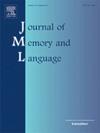Reframing linguistic bootstrapping as joint inference using visually-grounded grammar induction models
IF 3
1区 心理学
Q1 LINGUISTICS
引用次数: 0
Abstract
Semantic and syntactic bootstrapping posit that children use their prior knowledge of one linguistic domain, say syntactic relations, to help later acquire another, such as the meanings of new words. Empirical results supporting both theories may tempt us to believe that these are different independent learning strategies. Here, we argue for a unified approach, where instead they are both contingent on a more general learning strategy for language acquisition: joint learning. Using a series of neural visually-grounded grammar induction models, we demonstrate that both syntactic and semantic bootstrapping effects are strongest when syntax and semantics are learnt simultaneously via joint learning. This more general learning strategy results in better grammar induction, realistic lexical category learning, and better interpretations of novel sentence and verb meanings. Joint learning makes language acquisition easier for learners by mutually constraining the hypotheses spaces for both syntax and semantics. Studying the dynamics of joint inference over many input sources and modalities represents an important new direction for language modeling and learning research in both cognitive sciences and AI, as it may help us explain how language can be acquired in more constrained learning settings.
用视觉基础语法归纳模型重构语言自举作为联合推理
语义和句法引导假定儿童使用他们先前对一个语言领域的知识,比如句法关系,来帮助以后获得另一个语言领域的知识,比如新单词的意思。支持这两种理论的实证结果可能会诱使我们相信这是不同的独立学习策略。在这里,我们主张一种统一的方法,相反,它们都取决于一种更普遍的语言习得学习策略:联合学习。使用一系列基于神经视觉的语法归纳模型,我们证明了当语法和语义通过联合学习同时学习时,句法和语义的自举效应都是最强的。这种更普遍的学习策略有助于更好的语法归纳、现实的词汇类别学习以及对新句子和动词含义的更好解释。联合学习通过对句法和语义假设空间的相互约束,使学习者更容易习得语言。研究多种输入源和模态的联合推理动态是认知科学和人工智能中语言建模和学习研究的一个重要新方向,因为它可以帮助我们解释语言是如何在更有限的学习环境中习得的。
本文章由计算机程序翻译,如有差异,请以英文原文为准。
求助全文
约1分钟内获得全文
求助全文
来源期刊
CiteScore
8.70
自引率
14.00%
发文量
49
审稿时长
12.7 weeks
期刊介绍:
Articles in the Journal of Memory and Language contribute to the formulation of scientific issues and theories in the areas of memory, language comprehension and production, and cognitive processes. Special emphasis is given to research articles that provide new theoretical insights based on a carefully laid empirical foundation. The journal generally favors articles that provide multiple experiments. In addition, significant theoretical papers without new experimental findings may be published.
The Journal of Memory and Language is a valuable tool for cognitive scientists, including psychologists, linguists, and others interested in memory and learning, language, reading, and speech.
Research Areas include:
• Topics that illuminate aspects of memory or language processing
• Linguistics
• Neuropsychology.

 求助内容:
求助内容: 应助结果提醒方式:
应助结果提醒方式:


